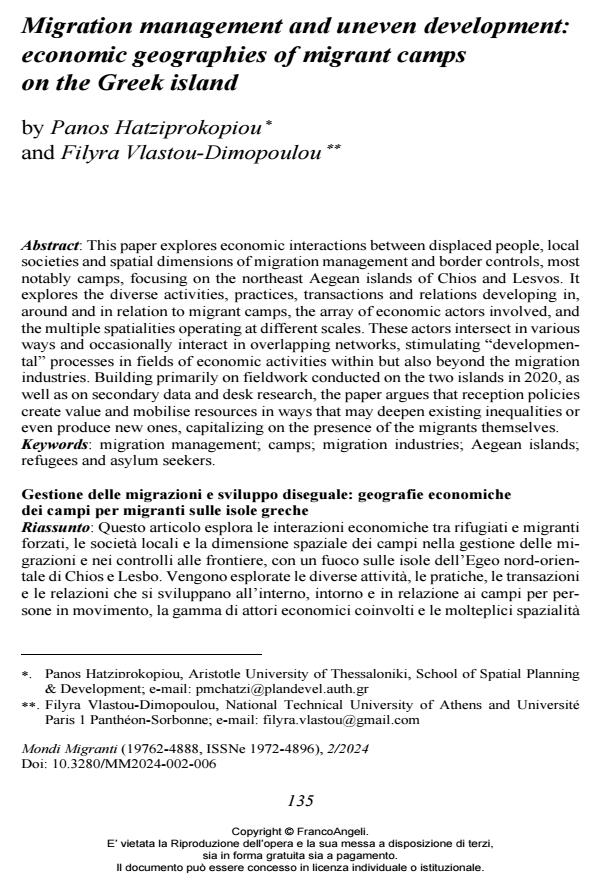Migration management and uneven development: economic geographies of migrant camps on the Greek island
Titolo Rivista MONDI MIGRANTI
Autori/Curatori Panos Hatziprokopiou, Filyra Vlastou-Dimopoulou
Anno di pubblicazione 2024 Fascicolo 2024/2
Lingua Inglese Numero pagine 24 P. 135-158 Dimensione file 250 KB
DOI 10.3280/MM2024-002006
Il DOI è il codice a barre della proprietà intellettuale: per saperne di più
clicca qui
Qui sotto puoi vedere in anteprima la prima pagina di questo articolo.
Se questo articolo ti interessa, lo puoi acquistare (e scaricare in formato pdf) seguendo le facili indicazioni per acquistare il download credit. Acquista Download Credits per scaricare questo Articolo in formato PDF

FrancoAngeli è membro della Publishers International Linking Association, Inc (PILA)associazione indipendente e non profit per facilitare (attraverso i servizi tecnologici implementati da CrossRef.org) l’accesso degli studiosi ai contenuti digitali nelle pubblicazioni professionali e scientifiche
This article focuses on Lampedusa as an exemplary case study of economic transformation brought about by migration, as well as the creation of a ‘migra-tion industry’. On the basis of interviews with key informants and a reconstruction of the secondary literature, it shows how migration has given international visibility to the island, starting from the first arrivals of emigrants in the 1990s, through the increase in landings during the so-called ‘Arab Spring’, and up to the pre-sent. This has fed various processes of conversion from an economy based on fishing towards an economy built around relatively recent tourism. Further-more, it highlights how the national, European and international policies of migration governance have contributed to creating an industry based on con-sumption by the military, police, volunteers, health and humanitarian person-nel present on the island and the impact this has had on the local service sec-tor.
L’articolo si focalizza su Lampedusa come caso studio esemplare di trasfor-mazione economica agita dall’immigrazione e di creazione di un vero e pro-prio ‘indotto migratorio’. Sulla base di interviste a testimoni privilegiati e ricostruzione della letteratura specializzata, si mostrerà come – a partire dai primi arrivi di emigranti sull’isola negli anni ’90, fino all’intensificazione degli sbarchi durante le così dette ‘Primavere arabe’ e negli anni recenti – l’immigrazione abbia dato visibi-lità internazionale all’isola, alimentando, così, processi di conversione di un’economia basata sulla pesca, a favore di un’economia costruita attorno a una relativamente recente vocazione turistica. Inoltre, verrà messo in luce co-me le politiche, nazionali e internazionali, di governo dell’immigrazione ab-biano contribuito a creare un indotto economico, costituito dai consumi e dall’impulso che il personale militare, delle forze dell’ordine, sanitario e uma-nitario, presente sull’isola, ha dato al terziario locale.
Parole chiave:industria migratoria; indotto migratorio; Lampedusa; turismo; rifugiati e richiedenti asilo.
- Camp studies trapped in the camp? Re-articulating recent Greek history through the camp as a productive device Lafazani Olga, in Political Geography 103447/2026 pp.103447
DOI: 10.1016/j.polgeo.2025.103447 - Energy as social relation: Refugees' energy commons for infrastructuring beyond the grid Maria Kaika, Charalampos Tsavdaroglou, in Energy Research & Social Science 104448/2025 pp.104448
DOI: 10.1016/j.erss.2025.104448
Panos Hatziprokopiou, Filyra Vlastou-Dimopoulou, Migration management and uneven development: economic geographies of migrant camps on the Greek island in "MONDI MIGRANTI" 2/2024, pp 135-158, DOI: 10.3280/MM2024-002006